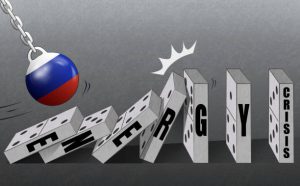When Russia invaded Ukraine a year ago, the shelves of the Novus supermarket chain in Kyiv quickly emptied as its supply chains – domestic and overseas – collapsed. Fresh produce became scarce and panic buying spread. Oleksiy Panasenko, deputy director general for operations at the popular outlet, recalls how the business reeled before Novus, like many other large retail chains, managed to adapt. “On the second day (of the war), there was already fighting on the outskirts of Kyiv,” he told Reuters. “In February and March, our shops became more than a place to buy food: they were a place to meet, to communicate; so-called islands of stability.” And when Ukrainian troops forced Russia’s army to retreat from the capital in the spring, the retail sector and the broader economy rebounded. Data from Ukraine’s European Business Association – which groups over 1,000 foreign and Ukrainian businesses – showed that by the end of May 47% of their members had fully restored operations and another 50% were working with some limitations. But then missile attacks began in October, dealing Ukraine a hammer blow. Russia struck at power grids and sub-stations across the country, leading to outages during the freezing winter and hitting heavy industry hard. The economy shrank by a third last year, the largest fall since Ukraine’s independence from the Soviet Union in 1991. Before Russia’s invasion, annual economic output had topped $200 billion. As the war enters its second year with no sign of slowing, the challenges are formidable. Reuters canvassed seven economists whose forecasts for 2023 ranged from a sizeable – though far less dramatic – decline of 5% in gross domestic product (GDP) to a small expansion. Access to reliable power will be a major obstacle. While many businesses are finding ways to cope with war, those that cannot run on generators alone will struggle this year, according to the economists, two government officials and executives from two private companies. ArcelorMittal (NYSE:MT) Kryvyi Rih, Ukraine’s largest steel mill, said its production was currently at about 25% of pre-war levels amid electricity blackouts. “We see small and medium-sized businesses adapt fairly quickly to power shortages by purchasing generators, batteries, and other equipment, while infrastructure damage remains moderate,” said Olena Bilan, chief economist at Dragon Capital investment house, whose forecast was the most negative among the economists surveyed. “If this situation persists, the fall in GDP in 2023 will not be as significant as we expect. But our forecast also envisages an end of the war’s hot phase at the end of third quarter of 2023,” said Bilan. She did not explain why Dragon expects the war will cool.

Ukraine’s Central Bank Predicts GDP Will Grow By 0.3% This Year, While The Economy Ministry Forecasts 3.2% Growth.
HUGE TOLL By last summer, Ukrainian officials had already started sounding more confident about the country’s economy, in particular after a UN-brokered grain export deal. The agreement saved Ukraine’s agriculture, which accounted for about 12% of GDP and some 40% of overall exports before the war. As of mid-February, Ukraine’s grain exports for the 2022-2023 season – which runs July to June – had fallen 29.3% year-on-year to 29.7 million tonnes. A massive increase in military spending, including army wages, has also provided a boost to the economy, said Vitaly Vavrishchuk, head of research at ICU investment house. Ukraine spent 1.5 trillion hryvnias ($40.6 billion) on its defence sector in 2022 – equivalent to around one-third of its economic output – according to the National Security Council. That was around five times higher than its planned pre-war defence budget. Tens of billions of dollars in foreign assistance have poured in, both to help plug the budget deficit and arm Ukrainian forces. But despite the positives, Ukraine is well behind where it was before the war began. And the economic toll is staggering. The invasion destroyed schools, hospitals, ports, roads and bridges. The Kyiv School of Economics estimated the damage to infrastructure due to the war at $138 billion as of December. Poverty rates have soared and the budget deficit is forecast to hit $38 billion in 2023 following a collapse in tax revenues. The government is depending on Western aid to cover it – most of it from the United States and the European Union. “Ukraine’s government took measures that helped to reduce the monthly deficit in 2023 to $3-3.5 billion, which is still a huge figure,” Finance Minister Serhiy Marchenko said, noting there was also a need for infrastructure investment to fuel a recovery. President Volodymyr Zelenskiy’s government has called on donors to start planning for the massive task of reconstruction this year, though it recognizes large scale building will be difficult until some peace returns. Between 40% and 60% of the energy sector has been damaged, according to Marchenko, who said at a recent roundtable in February that he could often hear attack drones buzzing above his house or the building of his ministry. Business events are often held in underground shelters for security. Blackouts are regular. Novus’s Panasenko said the company lost about 30% of the stores’ opening hours in Kyiv in December and some 20% in January. The steel sector, a key pillar of the economy, is among the hardest hit. Ukraine was the world’s 14th largest producer of steel before the war. Two leading steel producers, Azovstal and MMK Illicha in Mariupol, were destroyed and are officially bankrupt.

Those That Remain are Struggling With Power Outages.
“Blackouts for companies like us are a big issue,” Mauro Longobardo, general director of ArcelorMittal Kryvyi Rih. The company recently started to import electricity, but the costs were high. He did not provide further details. Ukraine’s electricity system is connected to the European grid, where prices are higher, and it has imported energy from neighbouring Slovakia. Energy deficits are not the only challenge for Arcelor. Its warehouse in Kryviy Rih, some 400 km (250 miles)southeast of Kyiv, was hit by three Russian missiles in early December and one worker was killed, Longobardo said. Arcelor’s mining facility in a recently liberated area was strewn with landmines and most of the related infrastructure damaged. Logistics are another headache for the company, which used to export up to 80% of its output. Russia blocked Ukraine’s Black Sea ports and Longobardo had to work on new export routes through Poland. Despite the challenges, Arcelor, Ukraine’s biggest foreign investor, is committed to stay. The largest employer in Kryviy Rih, the birthplace of Zelenskiy, it has kept its 26,000 employees on the payroll despite a production fall. Longobardo said Arcelor would invest $130 million this year. Such plans are rare now. The outlook for some other sectors is more positive. Economy ministry data showed Ukraine imported 669,400 generators last year, including over 300,000 in December alone. Panasenko said 52 out of Novus’s 82 stores were already equipped with generators. ICU’s Vavrishchuk saw the economy continuing to adapt, and sectors with high state financing would benefit the most. But obvious security risks were deterring private investments, crucial for a robust recovery. Ukraine has a mixed record on attracting foreign private investment. In 2021, it ranked as the second-lowest country in Europe on Transparency International’s Corruption Perceptions Index, behind only Russia. Vavrishchuk said the country would need to enforce the rule of law, ensure transparency and fair competition. “Participation in the post-war reconstruction could be attractive for investors,” he said. “But still we will have to address all those issues (transparency and corruption) that we have not had time to before the war began.”




